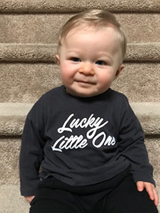Ventricular Septal Heart Defect (VSD): Roman’s Story
Ventricular Septal Heart Defect (VSD): Roman’s Story
Today, Roman is a bubbly and energetic 10-month-old who’s anxious to explore the world around him. He’s crawling all over and on the verge of walking — none of which would have been possible without surgery to fix an opening in the lower chambers of his heart at Children’s Hospital of Philadelphia (CHOP).

When Roman was born, there were no indications that he was anything but a healthy baby. His birth was uneventful and he passed all of his newborn screening tests.
But Roman’s family noticed he had trouble with feedings. He tired easily and at most feedings would only drink an ounce or two. Because of his limited intake, Roman needed to be fed more frequently — sometimes every hour through the day and at night.
At Roman’s one-month check-up, his parents asked his pediatrician about the frequent feedings and if anything was wrong with their son. The pediatrician performed an exam and heard a murmur in Roman's heart.
“She said it might be nothing,” remembers Meghan, Roman’s mother, “But that we should see a cardiologist to make sure.”
Imaging confirms an issue with his heart

Meghan made an appointment at CHOP’s Specialty Care Center in Mays Landing, NJ, with Terry Anderson, MD, an attending cardiologist with Children's Hospital of Philadelphia. Dr. Anderson also heard the murmur and performed an echocardiogram to look at Roman’s heart. The imaging showed Roman had a large opening between the two lower chambers of his heart, a condition known as ventricular septal defect (VSD).
When VSD openings are small, they can close naturally as the baby’s heart grows. When the VSD openings are large — and if they don’t close naturally — surgery is required. Dr. Anderson proposed a plan of monthly follow-ups to see if the hole in Roman’s heart would close on its own.
After three months, Dr. Anderson determined the ventricular septal defect was not closing on its own. He told Meghan and Vincent, Roman’s father, that their baby would need surgery.
Cardiac surgery in Philadelphia
A few weeks later, the family came to CHOP’s Main Campus in Philadelphia. Christopher Mascio, MD, an attending surgeon in CHOP’s Cardiac Center, would perform the procedure.
“We were nervous wrecks going in,” says Meghan.
“Dr. Mascio and the nurses put us at ease. I felt this calm that everything would go well.”
During Roman’s open-heart surgery, Dr. Mascio placed a small patch to close the hole between the left and right ventricles of Roman’s heart.
The procedure was a success, and Roman remained in the Hospital for a few days to recover and help his body heal.
Hitting all of his milestones

Once Roman returned home, his condition continued to improve. His energy level rose, he was able to eat more at feedings and was able to sleep longer. He was happier.
“It was like clockwork,” says Meghan. “What Dr. Mascio explained would happen is exactly what happened. Roman was awake and alert in bed the next day, playing as if nothing had happened.”
Now 10 months old, Roman is hitting all of his milestones. He’s sitting up, rolling over, and crawling all over the place. He pulls himself up to stand and will be walking soon.
Meghan and Vincent are thankful for the care Roman received at CHOP.
“Their love for children and caring for the parents is amazing. I don’t have the words to express my gratitude. ”
“It was the scariest thing you could ever imagine, and they put me at ease. They were so professional. There is no other place I would ever go,” adds Meghan.